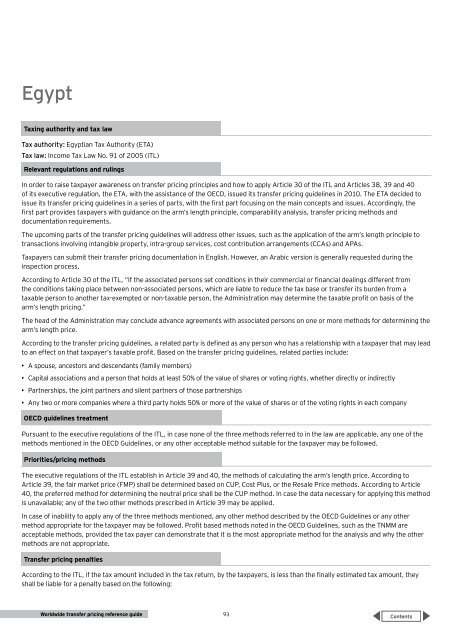Worldwide transfer pricing reference guide 2014
Create successful ePaper yourself
Turn your PDF publications into a flip-book with our unique Google optimized e-Paper software.
Egypt<br />
Taxing authority and tax law<br />
Tax authority: Egyptian Tax Authority (ETA)<br />
Tax law: Income Tax Law No. 91 of 2005 (ITL)<br />
Relevant regulations and rulings<br />
In order to raise taxpayer awareness on <strong>transfer</strong> <strong>pricing</strong> principles and how to apply Article 30 of the ITL and Articles 38, 39 and 40<br />
of its executive regulation, the ETA, with the assistance of the OECD, issued its <strong>transfer</strong> <strong>pricing</strong> <strong>guide</strong>lines in 2010. The ETA decided to<br />
issue its <strong>transfer</strong> <strong>pricing</strong> <strong>guide</strong>lines in a series of parts, with the first part focusing on the main concepts and issues. Accordingly, the<br />
first part provides taxpayers with guidance on the arm’s length principle, comparability analysis, <strong>transfer</strong> <strong>pricing</strong> methods and<br />
documentation requirements.<br />
The upcoming parts of the <strong>transfer</strong> <strong>pricing</strong> <strong>guide</strong>lines will address other issues, such as the application of the arm’s length principle to<br />
transactions involving intangible property, intra-group services, cost contribution arrangements (CCAs) and APAs.<br />
Taxpayers can submit their <strong>transfer</strong> <strong>pricing</strong> documentation in English. However, an Arabic version is generally requested during the<br />
inspection process.<br />
According to Article 30 of the ITL, “If the associated persons set conditions in their commercial or financial dealings different from<br />
the conditions taking place between non-associated persons, which are liable to reduce the tax base or <strong>transfer</strong> its burden from a<br />
taxable person to another tax-exempted or non-taxable person, the Administration may determine the taxable profit on basis of the<br />
arm’s length <strong>pricing</strong>.”<br />
The head of the Administration may conclude advance agreements with associated persons on one or more methods for determining the<br />
arm’s length price.<br />
According to the <strong>transfer</strong> <strong>pricing</strong> <strong>guide</strong>lines, a related party is defined as any person who has a relationship with a taxpayer that may lead<br />
to an effect on that taxpayer’s taxable profit. Based on the <strong>transfer</strong> <strong>pricing</strong> <strong>guide</strong>lines, related parties include:<br />
• A spouse, ancestors and descendants (family members)<br />
• Capital associations and a person that holds at least 50% of the value of shares or voting rights, whether directly or indirectly<br />
• Partnerships, the joint partners and silent partners of those partnerships<br />
• Any two or more companies where a third party holds 50% or more of the value of shares or of the voting rights in each company<br />
OECD <strong>guide</strong>lines treatment<br />
Pursuant to the executive regulations of the ITL, in case none of the three methods referred to in the law are applicable, any one of the<br />
methods mentioned in the OECD Guidelines, or any other acceptable method suitable for the taxpayer may be followed.<br />
Priorities/<strong>pricing</strong> methods<br />
The executive regulations of the ITL establish in Article 39 and 40, the methods of calculating the arm’s length price. According to<br />
Article 39, the fair market price (FMP) shall be determined based on CUP, Cost Plus, or the Resale Price methods. According to Article<br />
40, the preferred method for determining the neutral price shall be the CUP method. In case the data necessary for applying this method<br />
is unavailable; any of the two other methods prescribed in Article 39 may be applied.<br />
In case of inability to apply any of the three methods mentioned, any other method described by the OECD Guidelines or any other<br />
method appropriate for the taxpayer may be followed. Profit based methods noted in the OECD Guidelines, such as the TNMM are<br />
acceptable methods, provided the tax payer can demonstrate that it is the most appropriate method for the analysis and why the other<br />
methods are not appropriate.<br />
Transfer <strong>pricing</strong> penalties<br />
According to the ITL, if the tax amount included in the tax return, by the taxpayers, is less than the finally estimated tax amount, they<br />
shall be liable for a penalty based on the following:<br />
<strong>Worldwide</strong> <strong>transfer</strong> <strong>pricing</strong> <strong>reference</strong> <strong>guide</strong><br />
93


